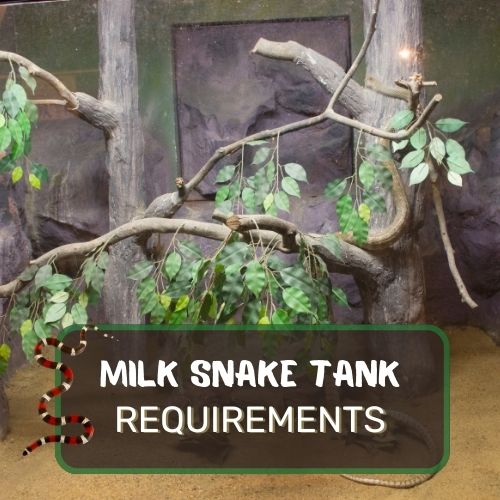Ever caught yourself wondering, “What’s on a milk snake’s menu?” You’re not alone! These vibrant reptiles have dietary preferences as colorful as their scales.
Absolutely! Milk snakes can eat eggs, especially those of ground-nesting birds and reptiles. While eggs can provide nutrition, they’re typically an occasional treat rather than a staple in their diet. It’s always essential to offer a varied diet to ensure they get a balanced intake of nutrients.
In this deep dive, we’ll unpack the milk snake’s gastronomic choices, from their love for rodents to their occasional flirtation with eggs. We’ll also explore the dietary dos and don’ts for captive milk snakes, with insights from herpetologists.
Got questions?
Our FAQ section will tackle those head-on. Ready to become a milk snake dietary expert? Let’s slither into it!

Table of Contents
General Dietary Preferences of Milk Snakes
Hey there, fellow curious soul! Ever found yourself gazing at a milk snake and pondering, “What exactly does this colorful creature feast on?” Well, you’re in luck because we’re about to dive deep into the gastronomic world of the milk snake.
Let’s roll!
Milk snakes are primarily carnivorous.
Milk snakes aren’t sipping on kale smoothies or nibbling on veggies. Nature has crafted them to be true-blue carnivores. So, what does that mean? They have a penchant for live fare, and plant-based diets?
Not so much their thing.
They love small rodents, birds, and reptiles.
Picture this: It’s a sunny day, and our vibrant friend, the milk snake, is taking a casual slither through the woods. Suddenly, a mouse scampers by. It’s a no-brainer – snack time! For milk snakes, small critters like mice and juvenile rats are the ultimate treat.
Think of it as their version of fast food!
But that’s not where their culinary adventure ends. Ground-nesting birds might find their eggs, or even their chicks, in jeopardy if a milk snake is lurking nearby. And, believe it or not, our milk snake isn’t too picky.
If it gets a chance, it won’t hesitate to snack on fellow reptiles either. Lizards or smaller snakes? All fair game in the world of milk snake dining.
And now, with this delectable buffet laid out, the big question arises: “Do eggs find a place on this menu? Can a milk snake be tempted by an egg breakfast in the wild?”
Sure, they’ve got rodents, birds, and fellow reptiles on their plate, but where do eggs fit in? That’s the burning query we’re about to crack open!

Why Eggs Could Be an Attractive Meal
Let’s dissect this culinary curiosity and see what makes eggs a possible contender in the milk snake’s menu.
Protein content in eggs.
If eggs were to have a resume, “rich in protein” would be right at the top. And guess what? Protein is like the ultimate power food for many animals, snakes included.
It helps in muscle development, tissue repair, and provides the necessary energy for all their slithering escapades. Think of it as the gym protein shake for snakes. If milk snakes are looking for a quick protein fix, eggs could very well be on their radar!
Other nutritional components.
But eggs aren’t just about protein. Oh no, they’re a whole nutrition party! Vitamins, minerals, good fats – you name it, and eggs probably have it.
For instance, the yolk is a great source of Vitamin D, which is essential for calcium absorption and bone health. If a milk snake gets a hold of an egg, it’s not just munching on protein; it’s indulging in a full-course nutritious meal.
Can eggs be a staple in their diet?
Now, while eggs seem like a fantastic food option, would they be the main course in a milk snake’s dietary regimen? Not quite. Milk snakes, given their varied diet in the wild, would have a buffet of choices, with eggs being just one of them.
While they might snack on an egg occasionally, relying solely on them isn’t the norm. Diversity is the spice of life, and this holds true for our slithering friends as well!
Any risks associated with egg consumption?
Eggs sound great so far, right? But like any good thing, moderation is key. Consuming too many eggs might lead to a nutritional imbalance for the milk snake. Moreover, the physical act of consuming larger eggs might pose a choking hazard.
Additionally, wild eggs might sometimes harbor parasites or infections. So, while an occasional egg might be a treat, it’s essential to ensure it’s safe and to balance it out with other food sources.

What Kinds of Eggs Do Milk Snakes Prefer?
Ah, the big question! If milk snakes were to join an egg tasting event, what would be their pick? Let’s dive in!
Bird eggs vs. reptile eggs.
Milk snakes aren’t too fussy, but they do have preferences. Bird eggs, especially those from ground-nesting birds, can be quite tempting. They’re often more accessible and easier to find.
However, reptile eggs, especially those from lizards or turtles, aren’t off the table either. If the opportunity arises, a milk snake wouldn’t mind indulging in some reptilian roe.
Size matters: going for the smaller ones.
Like us choosing bite-sized appetizers, milk snakes tend to prefer smaller eggs. They’re easier to swallow and present fewer risks during the consumption process. So, smaller bird or reptile eggs would be the top picks in a milk snake egg-feast!

Feeding Eggs to Captive Milk Snakes: The Do’s and Don’ts
Keeping a milk snake? Considering adding eggs to its diet? Hold that thought, and let’s navigate the do’s and don’ts first.
Proper preparation of the egg.
For captive snakes, always ensure that the eggs are fresh and free from contaminants. It’s also best to source eggs from reputable breeders or suppliers. The idea is to provide the snake with a clean and safe snack, minimizing risks of parasites or infections.
How often should captive milk snakes be fed eggs?
While eggs can be nutritious, they shouldn’t be the daily fare. Offering eggs once every few weeks can be a delightful treat. Remember, variety is key to a balanced diet.
Any health issues to watch out for?
Overfeeding eggs can lead to nutritional imbalances. Also, observe your snake after feeding. If you notice any changes in behavior, digestive issues, or if the snake seems uncomfortable, it’s best to consult with a reptile vet.
Eggs can sometimes be a choking hazard, especially if they’re too big. So, always prioritize the snake’s health and safety.

Alternatives to Eggs in a Captive Milk Snake’s Diet
Roll out the red carpet, because we’re about to introduce some VIP (Very Important Prey) alternatives for our captive milk snakes. While eggs are a tantalizing treat, they’re just one of the many delectable options available. Let’s explore!
Other nutritious food options.
First on the list? Rodents! Mice, in particular, are like the ultimate superfood for milk snakes. They’re packed with protein and other essential nutrients. Plus, they come in convenient sizes, from pinkie mice for younger snakes to larger ones for full-grown adults.
Next up, we have small birds. Baby quails or other petite birds can be a nutritious choice, though they’re more of an occasional dish rather than a regular one.
Lastly, don’t forget reptiles! While it might sound a tad morbid, smaller lizards or amphibians can be on the menu too, especially if you’re trying to replicate their natural diet.
Balancing their diet for optimal health.
It’s not just about what they eat but how often they eat it. Mixing up their diet ensures they get a balanced intake of nutrients. Think of it as us humans having fruits, veggies, proteins, and grains in rotation.
Recommendations from herpetologists.
Experts in the field of herpetology often emphasize the importance of mimicking a milk snake’s natural diet in captivity. They suggest a varied diet, with rodents being the primary food source.
Eggs, birds, and other reptiles can be introduced occasionally to add diversity. And always, always ensure the prey’s size is appropriate for the snake. Remember, feeding shouldn’t be a challenge or a risk.
Diversity is the name of the game when it comes to feeding captive milk snakes. While eggs can be a tasty treat, it’s the mix of various foods that keeps our slithery friends happy, healthy, and thriving. Always keep those taste buds guessing!
Summary
In your journey to understand milk snakes and their dietary choices, you’ve discovered that these vibrant reptiles have a varied palette. From rodents to the occasional egg, their diet is as diverse as nature itself.
Remember, whether you’re a curious mind or a snake owner, knowledge is power. The more you understand about these fascinating creatures, the better. Keep that curiosity alive, and continue exploring the wonders of the animal kingdom.
Your thirst for knowledge makes the world a richer place. Keep learning and keep growing!
FAQ
Alright, rapid-fire round! Let’s tackle some of the most burning questions surrounding our colorful, slithery friends, the milk snakes. On your marks, get set, go!
What can you feed milk snakes?
Milk snakes aren’t picky eaters! Their menu mainly features rodents like mice, but they also enjoy the occasional bird, reptile, or yes, even an egg. The key? Variety and appropriateness in size.
Do milk snakes eat meat?
Absolutely! Milk snakes are carnivores by nature. So, whether it’s a juicy mouse, a small bird, or even another reptile, meat is their primary food group. Vegetarian diet? Not in their playbook.
Do milk snakes need water?
You bet! Just like us, hydration is crucial for milk snakes. Always ensure they have access to fresh, clean water. It aids in digestion, keeps them hydrated, and occasionally, you might even catch them taking a little water bath!




0 Comments